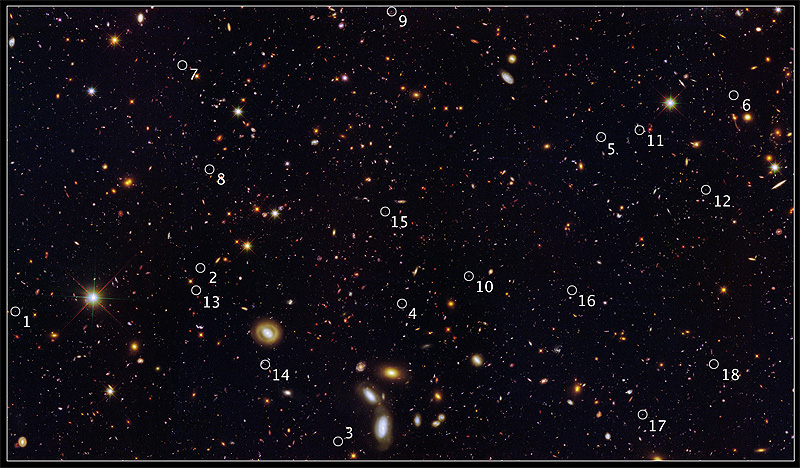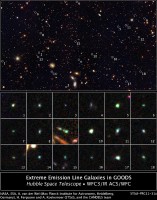This image reveals 18 tiny galaxies uncovered by NASA’s Hubble Space Telescope. The puny galaxies, shown in the postage stamp-sized images, existed 9 billion years ago and are brimming with star birth. Hubble’s Wide Field Camera 3 and Advanced Camera for Surveys spied the galaxies in a field called the Great Observatories Origins Deep Survey (GOODS). (Credit: NASA, ESA, A. van der Wel (Max Planck Institute for Astronomy, Heidelberg, Germany), H. Ferguson and A. Koekemoer (STScI.), and the CANDELS team)
Home This image reveals 18 tiny galaxies uncovered by NASA’s Hubble Space Telescope. The puny galaxies, shown in the postage stamp-sized images, existed 9 billion years ago and are brimming with star birth. Hubble’s Wide Field Camera 3 and Advanced Camera for Surveys spied the galaxies in a field called the Great Observatories Origins Deep Survey (GOODS). (Credit: NASA, ESA, A. van der Wel (Max Planck Institute for Astronomy, Heidelberg, Germany), H. Ferguson and A. Koekemoer (STScI.), and the CANDELS team) This image reveals 18 tiny galaxies uncovered by NASA's Hubble Space Telescope. The puny galaxies, shown in the postage stamp-sized images, existed 9 billion years ago and are brimming with star birth. Hubble's Wide Field Camera 3 and Advanced Camera for Surveys spied the galaxies in a field called the Great Observatories Origins Deep Survey (GOODS). (Credit: NASA, ESA, A. van der Wel (Max Planck Institute for Astronomy, Heidelberg, Germany), H. Ferguson and A. Koekemoer (STScI.), and the CANDELS team)
This image reveals 18 tiny galaxies uncovered by NASA’s Hubble Space Telescope. The puny galaxies, shown in the postage stamp-sized images, existed 9 billion years ago and are brimming with star birth. Hubble’s Wide Field Camera 3 and Advanced Camera for Surveys spied the galaxies in a field called the Great Observatories Origins Deep Survey (GOODS). (Credit: NASA, ESA, A. van der Wel (Max Planck Institute for Astronomy, Heidelberg, Germany), H. Ferguson and A. Koekemoer (STScI.), and the CANDELS team)



